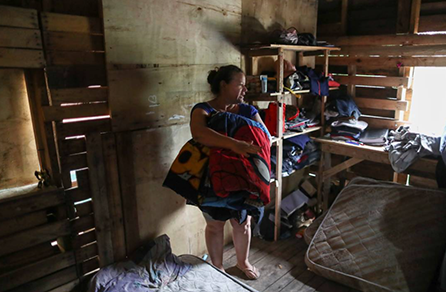By Miguel Lobianco and Juan Bustamante
MANZANARES, Argentina, April 13, 2021 (Reuters) – In a run-down part of Manzanares, on the outskirts of Buenos Aires, the scars of poverty are clear. People cook with firewood. Some have no electricity, gas or running water. Children play barefoot with old toys next to rudimentary homes.
It is a stark reflection of a wider issue gripping Argentina, which a century ago was once of the richest countries in the world. By the end of last year, the poverty level was at 42%, up from 35.5% a year earlier, rising amid the impact of the coronavirus pandemic and three years of recession.
“Here we live day to day. We do not know what will happen tomorrow, if we will make it or won’t get to eat,” said Aida Mariela Unayche, a 43-year-old who is unemployed and has two teenage children.
“Poverty leads you to this… We no longer have the right to anything. We’ve lost everything, even dignity,” added Unayche, who said she completed high school but who now lives on donations and what she can scavenge.
Argentina’s economy has been ravaged by years of fierce economic crisis and high inflation that has sapped people’s savings and spending power and pushed up prices.
Before the pandemic, 8 million Argentines received food assistance, a figure that has now grown to 10 million, in a population of around 45 million people.
“The price of food is Argentina’s most critical problem. What we see is people doing informal jobs, working but then also going to soup kitchens to make ends meet,” Minister of Social Development Daniel Arroyo told Reuters.
The center-left Peronist government of President Alberto Fernández is keen to make inroads in reducing poverty to bolster its position ahead of October mid-term elections, with many of the party’s core voters living in the less affluent areas around Buenos Aires.
The Ministry of Social Development had a budget of $2.6 billion in 2020 to alleviate the economic effects of the coronavirus pandemic lockdowns. In 2021 there could be further measures, Arroyo said, without giving details.
Argentina has relatively high levels of welfare assistance for Latin America, but a large part of the social subsidies have been financed with money printing that has fueled inflation, in turn stoking poverty. Argentina’s economy is forecast to grow 6.7% this year, with inflation at 46%, a recent central bank poll showed.
“The first year of the pandemic was very difficult, I was left without work,” said María Núñez, a 42-year-old unemployed woman from Manzanares with 10 children.
“I always worked as a domestic worker and it was all very sudden. My husband was also without work and all my children. It was very hard for everyone.”
(Reporting by Miguel Lo Bianco and Juan Bustamante, Writing by Agustín Geist; Editing by Nicolás Misculin, Adam Jourdan and Rosalba O’Brien)










